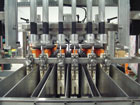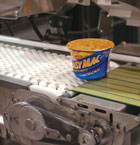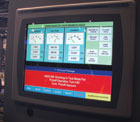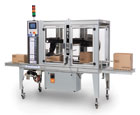
As trays replace shipping cases, end-of-line machinery needs to make accommodations.(Photo courtesy Standard-Knapp)
Most of that attention has centered on the packaging itself. But what role can machines play in sustainability?
Our coverage looks at two major aspects of machinery sustainability. “Packaging lines do more with less” examines how machines handle lighter, thinner materials. “Packaging machinery plugs into energy-conservation mode,” on page 22, shows how the right machinery and controls can consume less energy.
Packaging lines doing more with less
As materials become thinner, or even disappear, machinery must have the capability to adjust.
by Pan Demetrakakes, Editor, and Rick Lingle, Executive Editor
Material reduction is one of the most common strategies for increasing the sustainability of packaging. It’s tangible and visible, often at the consumer level, and it almost always saves money.
But as packaging materials, both primary and secondary, get lighter and thinner, the machines that apply and handle them often have to adjust. Running thinner materials, and fewer of them, can require equipment to do things differently. Adjustments can range from simple tweaks to entirely new parts, or even new machinery.
One of the biggest trends in material downsizing has been in polyethylene terephthalate (PET) bottles, especially for bottled water. The weight has gone as low as under 10 grams, which has serious implications for handling machinery. Mike Weaver, president and co-CEO of Standard-Knapp, calls them “bags masquerading as bottles.”
Moving such bottles along requires regulating the pressure they generate as they travel down the line. Standard-Knapp has instituted offset lane guides, which zigzag the product instead of moving it in a straight line, reducing the back pressure. (These can be retrofits as well as options for new equipment.) “The bottles from upstream sort of force the [downstream] bottles to hug the rails tightly,” Weaver says. “The harder they push, the harder they hug the rails, which results in diminished line pressure.”
Even something as seemingly simple as putting a pressure-sensitive label on a bottle becomes a challenge when the bottle walls get too thin, says Chuck Wepler, VP and general manager of Quadrel Labeling Systems.
“They’ve gotten to be such thin walls that the whole side of the container is like a football-it’s got a compound curve to it,” Wepler says. “And so you have to really put a lot of pressure on the squeegee on that label so that it overcomes the compound curve. And as a consequence, there are things we have to do. We have to beef up the drives, make it stronger.”
Labels are also getting thinner, which can create its own problems. With some pressure-sensitive labels, both the actual label and the backing liner are getting thinner, making them harder for some machines to handle. The problem is that the “die strike” that cuts the label’s outline against the liner may go too deep, weakening the liner and making the web liable to snap on the labeler.

As containers become lighter, aspects of material handling like transfers across conveyor segments become more of a challenge. (Photo courtesy Dorner Manufacturing Corp.)
Flex handling
Flexible materials can also present challenges. As flexible packaging replaces rigid containers in certain applications, it has implications for material handling.For one thing, transfer across conveyor gaps-such as when product is entering or leaving the infeed/outfeed conveyors of devices like checkweighers-becomes trickier for flexible packaging in many applications, says Mike Hosch, director of product development for Dorner Manufacturing Corp. Because the bottoms of the packages are not consistent, doing the transfer with a small-diameter roller may not suffice; Dorner has power-roller transfers available for such applications.
Another material-handling problem occurs when bags or pouches are so light that the seal fails and the package spills onto the conveyor. When this is more liable to happen, it creates a sanitation issue.
“The result of that is, conveyors that would typically not be required to have sanitary requirements now need to have sanitary requirements,” Hosch says. “Because of the accidental spillage, plant personnel need to go in and occasionally clean the conveyor. With that, we’re seeing kind of a middle-of-the-road stainless steel conveyor that doesn’t have the full requirements that you would see at the processing end, but at least needs to be corrosion-resistant and sanitary to the level that you can clean the occasional spillage and package breakage.”
Light and gentle
The implications of material reduction are especially acute for end-of-line machinery. When extra-light bottles are being put into cases, they have to be handled extra-gently.When bottles approach a drop-in case packer, the right number of them-that is, the number that will go into the shipping case-must fit into a “window,” an area within which they will be picked up and dropped into the case. The variable line pressure required by lightweight bottles can make that problematic. At high pressure, an extra bottle (or a fraction of one) will squeeze into the window; at low pressure, a bottle may go missing. The answer, says Standard-Knapp’s Weaver, is first to regulate pressure effectively, and second, to use a retracting mechanism that allows the bottles to “relax” once they’re under control and about to be dropped.
“What we have to do with the newer, lighter-weight [bottles] is make that [retracting mechanism] variable,” he says. “It used to always be fixed-value.”
Even if the primary containers don’t present any handling issues, secondary packaging-shipping cases, slipsheets and the like-often is a target for reduction. That has a direct impact for end-of-line equipment such as case packers, palletizers and stretchwrappers.
One common strategy is to eliminate shipping cases entirely, putting cartons or other primary packages on pallets “naked.” That means the palletizer has to handle primary packaging units, like beverage six- or 12-packs, instead of cases.
This increases end-of-line challenges many-fold. In such an application, the packager usually wants to run the fillers and other upstream equipment at the same pace, meaning that the palletizer has to handle three times or more the number of less stable units.
Not only is the load going into the palletizer less stable; so is the load on the pallet. Standard cases can quite easily be built into interlocking loads, where the gaps between cases alternate. But as the units on the pallet become smaller, column stacking, which is inherently less stable, becomes the only alternative.
Downgauging materials is a good way to be kind to the environment and save money. But it’ll go easier for those end users who go into the project with clear anticipation of what machinery adjustments have to be made to accommodate the reductions. F&BP
For More Information
Dorner Manufacturing Corp.
800-379-8664; www.dorner.com
Quadrel Labeling Systems
800-321-8509; www.quadrel.com
Standard-Knapp
860-342-1100; www.standard-knapp.com

Companies are more open to energy-conservation aids, such as this operator panel found on a case packer that has an energy-monitoring screen.
Sustainability-driven developments in packaging machinery center on energy savings.
by Rick Lingle, Executive Editor
Interest and developments in sustainability permeates most of the packaging industry, especially on the materials side. However, the greening of packaging machinery also continues to take root, especially as it relates to energy savings.
Rockwell Automation’s Machine Builder Solutions initiative is headed by Doug Burns, sustainability lead for services. “One of the program’s main focuses is how to drive energy use out of machines and out of facilities,” he says. “Especially in the food and beverage industries, end users have already done the ‘easier’ things, such as optimizing air compressors and adding energy-efficient lighting. Now they’re looking at processing and packaging equipment as the next level of their energy-reduction goals.”
That approach parallels a major shift in mindset for machinery manufacturers, according to Leo Petrokonis, Rockwell’s business development manager. “For many years, machinery builders did not take a look at energy usage,” he says. “Instead, they focused on the quality of the throughput and uptime. Today, they are much more aware of energy usage as a component in machine design.”
That awareness has already been turned into reality by packaging machinery suppliers. Schneider Packaging Equipment uses a Rockwell Automation Allen-Bradley PanelView Plus 1500 human-machine interface on the company’s servo-enhanced Model HCP 10 horizontal case packer. Besides showing Overall Equipment Effectiveness (OEE), RA’s PowerMonitor 1000 software provides energy monitoring data.

This case sealer offers a hibernation mode, a feature commonly found on laptop computers that is finding its way into packaging machines as a way to save energy during slowdowns and stoppages. (Photo courtesy Wexxar Packaging)
Hibernating like a laptop
Another trend is borrowed from laptops: Machinery that goes into standby or hibernation mode when appropriate. The new BEL 290 fully automatic case sealer from the Wexxar/BEL division of Pro Mach is designed to minimize energy waste during slow or paused case production upstream. It “hibernates” when case flow stops for 60 to 90 seconds and automatically restarts when case flow resumes.“Our customers have told us that environmental and sustainability issues are important to them,” says William Chu, general manager at Wexxar. “We looked at ways we could help them save energy costs while at the same time meet the demands of their heavy-duty, industrial applications.”
John Kowal, a packaging automation expert now with B & R Industrial Automation, says “packagers should consider that machinery that isn’t operating is also using up energy in terms of HVAC and lighting.”
Jack Aguero, Pro Mach VP, business development and marketing, believes that the packaging machinery end user market is waiting for Packaging Machinery Manufacturers Institute machinery members to develop solutions that offer sustainability benefits. “We’re beginning to see people become educated about it,” Aguero says.
Kowal reminds us that making products right the first time-a philosophy that’s been around for decades and is a component of OEE-is a great way to save energy because there’s no rework needed for good product.
OEE expert Paul Mancini of software provider Zarpac Performance Index (ZPI) Inc. says there is a direct correlation between OEE and energy use, but it’s not accounted for in basic OEE software. However, ZPI software does track inputs like energy and water usage to correlate to actual events on manufacturing lines, he points out. “Some customers have begun to use this data, with some degree of success, but the comparison of sustainability metrics with reliability metrics is still relatively new,” Mancini adds.
Another factor is regulation: beginning December 19, 2010, the Energy Independence & Securities Act will be enforced for certain electric motors. Educational resources are available at vendor sites, including that of Baldor. Baldor’s downloadable software permits customers to compare the efficiency and annual electricity usage of existing motors versus upgrading to more energy-efficient motors and provides an estimated payback.
Becoming proactive on energy reductions is already the hallmark of world-class companies. A benchmarking study released in late 2009 by the Aberdeen Group showed that best-in-class manufacturers typically cut their energy use by 24% versus “laggard” companies that increase their energy use by 6%. The report, Sustainable Production: Good for the Plant, Good for the Planet, also shows that leading companies provide executives with real-time visibility into energy data. The upshot: Companies need to provide visibility into their environmental data in order to reduce energy consumption and emissions in their manufacturing operations.
Visibility means measurements for establishing a baseline as a starting point-a must, say industry experts.
“Companies have to establish a benchmark within their plant or organization,” says Rockwell’s Petrokonis. “They need to figure out how they were using energy before, how are they using it now, and how are they going to use it tomorrow.”
Those are the questions. It’s advisable that packagers seek answers, if only because it will save their operations money. F&BP
SIDEBAR: Eco-minded machinery tips
This machinery-builder directed advice from Rockwell Automation is also applicable for packaging production personnel.
Cradle-to-Cradle Machine Design-a more flexible machine for multiple purposes that can be reconfigured later for a different operation and thus prolongs the machine’s useful life.
Design for Safety-integrate safety functionality into automation controllers, drives and motion solutions that helps increase productivity and minimize downtime, and thereby provide substantial savings.
Focus on Energy-integrate technologies such as mechatronics, variable-frequency drives (VFD), hydraulics, and servo and linear motion devices to minimize energy usage. Also consider alternative and reusable energy options.
Productivity-reduce downtime by using vibration-monitoring technology, integrating safety, and implementing software to generate metrics on machine performance to help increase overall equipment effectiveness (OEE).
Remote Monitoring-troubleshoot equipment from afar to reduce travel, time and energy usage for maintenance personnel who normally would drive to the plant.
For More Information
Aberdeen Group
800-577-7891; www.aberdeen.com
B & R Automation
770-772-0400; www.br-automation.com
Baldor Electric Co.
479-646-4711; www.baldor.com
Rockwell Automation
414-382-2568; www.rockwellautomation.com
Schneider Packaging Equipment
315-676-3035; www.schneiderequip.com
Wexxar Packaging, a div. of Pro Mach
888-565-3219; www.wexxar.com
Zarpac Performance Index Inc.
905-338-8880; www.zarpacpi.com
